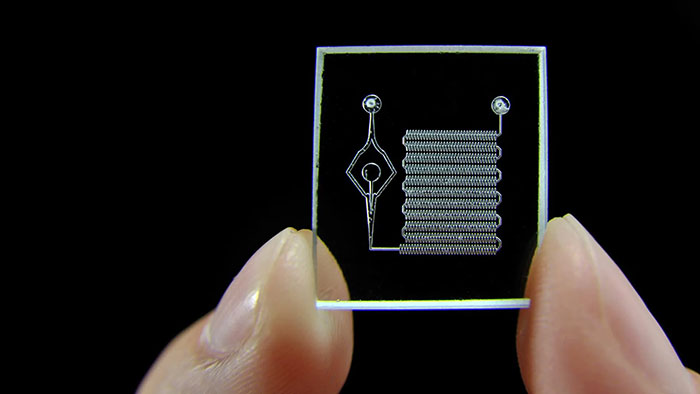Lab-on-a-Chip: Miniaturizing Laboratory Processes
What is Lab-on-a-Chip?
Lab-on-a-chip (LOC) is a revolutionary technology that integrates multiple laboratory functions on a single chip, typically only a few square millimeters to a few square centimeters in size. By miniaturizing and automating complex biochemical processes, LOC devices enable rapid, sensitive, and high-throughput analysis of biological samples, such as blood, urine, or DNA.

Key Features of Lab-on-a-Chip
Lab-on-a-chip devices possess several key features that distinguish them from traditional laboratory equipment:
- Microfluidics: LOC devices rely on microfluidic technology, which involves the manipulation of fluids in channels with dimensions ranging from tens to hundreds of micrometers. Microfluidics enables precise control over fluid flow, mixing, and reactions, allowing for efficient sample processing and analysis.
- Integration: LOC devices integrate various laboratory functions, such as sample preparation, separation, reaction, and detection, onto a single chip. This integration reduces the need for manual intervention, minimizes sample and reagent consumption, and improves the speed and accuracy of the analysis.
- Miniaturization: By miniaturizing laboratory processes, LOC devices significantly reduce the required sample and reagent volumes, leading to cost savings and reduced waste generation. Miniaturization also enables the development of portable and point-of-care diagnostic devices.
Fabrication of Lab-on-a-Chip Devices
Lab-on-a-chip devices are typically fabricated using microfabrication techniques borrowed from the semiconductor industry. The main steps in LOC fabrication include:
- Design: The layout and functionality of the LOC device are designed using computer-aided design (CAD) software. The design includes the microfluidic channels, reaction chambers, and integrated sensors or detectors.
- Master Fabrication: A master mold of the designed LOC device is created using photolithography or soft lithography techniques. The master serves as a template for the replication of the microfluidic structures.
- Replication: The microfluidic structures are replicated from the master mold using materials such as polydimethylsiloxane (PDMS), a flexible and optically transparent polymer. The replicated structures are then bonded to a substrate, such as glass or plastic, to form the complete LOC device.
- Integration: Additional components, such as electrodes, sensors, or microvalves, are integrated into the LOC device as needed. These components enable the control and monitoring of fluid flow, as well as the detection and analysis of samples.
Applications of Lab-on-a-Chip
Lab-on-a-chip technology has a wide range of applications across various fields, including:
Biomedical Diagnostics
LOC devices are particularly well-suited for point-of-care diagnostics, enabling rapid and accurate detection of diseases, infections, and genetic disorders. By integrating sample preparation, amplification, and detection on a single chip, LOC devices can provide timely and reliable diagnostic results, even in resource-limited settings.
Drug Discovery and Development
LOC technology accelerates the drug discovery and development process by enabling high-throughput screening of drug candidates. Microfluidic devices can be used to test the efficacy and toxicity of drugs on cell cultures or tissue models, reducing the need for animal testing and improving the efficiency of the drug development pipeline.
Environmental Monitoring
LOC devices can be employed for on-site monitoring of environmental pollutants, such as heavy metals, pesticides, or pathogens. By integrating sample pretreatment, separation, and detection on a single chip, LOC devices provide rapid and sensitive analysis of environmental samples, enabling early detection and remediation of contamination.
Advantages of Lab-on-a-Chip
Lab-on-a-chip technology offers several advantages over traditional laboratory methods:
- Reduced Sample and Reagent Volumes: LOC devices require minimal sample and reagent volumes, typically in the range of microliters to nanoliters. This reduction in volume leads to cost savings, reduced waste generation, and improved safety when dealing with hazardous materials.
- Faster Analysis: By integrating and automating multiple laboratory processes on a single chip, LOC devices significantly reduce the time required for sample preparation, reaction, and analysis. This acceleration enables high-throughput screening and rapid diagnostic testing.
- Enhanced Sensitivity and Specificity: The miniaturization and precise control of fluid flow in LOC devices lead to improved sensitivity and specificity in sample analysis. The high surface-to-volume ratio in microfluidic channels enhances the efficiency of biochemical reactions and improves the limit of detection.
- Portability and Point-of-Care Use: LOC devices are compact, portable, and can be operated with minimal instrumentation. This portability enables the deployment of LOC devices in point-of-care settings, such as clinics, emergency rooms, or remote locations, bringing laboratory-grade analysis closer to the patient or sample source.
Challenges and Future Perspectives
Despite the numerous advantages of lab-on-a-chip technology, several challenges need to be addressed for its widespread adoption. One of the main challenges is the integration of multiple functionalities on a single chip while maintaining the reliability and robustness of the device. The development of standardized manufacturing processes and quality control methods is crucial for the mass production and commercialization of LOC devices.
Future research in lab-on-a-chip technology will focus on the development of novel materials and fabrication techniques to improve the performance and functionality of LOC devices. The integration of advanced sensing and detection methods, such as nanomaterials-based sensors or optical detection, will enhance the sensitivity and multiplexing capabilities of LOC devices. Additionally, the incorporation of machine learning and artificial intelligence algorithms will enable the automated analysis and interpretation of the complex data generated by LOC devices.
Further Reading
Frontiers in Lab on a Chip Technologies, Challenges in lab-on-a-chip technology
